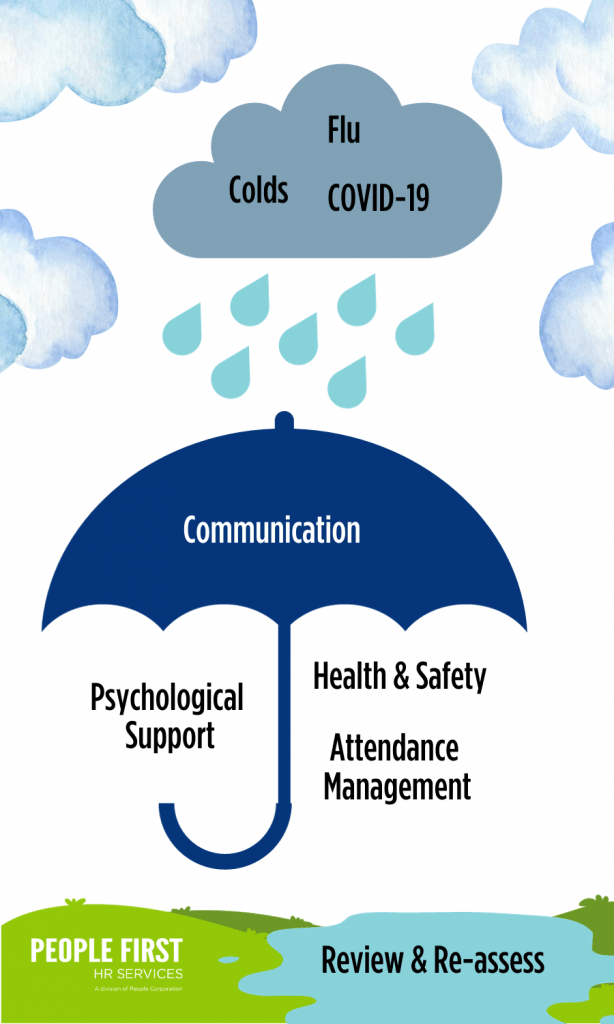by HR @ Your Service
The workplace environment has transformed in response to the challenges posed by the COVID-19 pandemic. As we approach cold and flu season and witness a resurgence of COVID-19 cases, employers are faced with the crucial task of addressing employee and workplace concerns in a proactive and strategic manner. The health and well-being of employees, alongside the efficient mitigation of illness transmission, should remain a top priority.
Workplaces should consider reviewing and implementing various strategies for managing illnesses to minimize the impact to their workforce. Additionally, they should regularly re-evaluate safety and health practices and wellness initiatives aimed at preventing the spread of germs and prioritizing the well-being of employees.
Communication
Effective communication is essential in establishing expectations regarding symptoms in the workplace, health and safety practices and attendance management. Establishing clear and consistent channels of communication ensures that employees are well-informed about the organization’s response to the upcoming challenges. Regular updates assist in alleviating anxiety by providing accurate and up-to-date information about safety measures, vaccination resources, and any changes in workplace policies aimed at mitigating illness transmission.
Communicating and engaging with employees when determining safety measures can be highly beneficial. Seeking their input and feedback through appropriate channels (i.e., Workplace Health & Safety Committees) can provide employees with a sense of being heard and valued.
Managing Attendance
Attendance management systems can be used to monitor and report on employee attendance, making it easier to identify absenteeism trends or patterns that may be indicative of illness outbreaks. By promptly identifying these patterns, steps can be taken to proactively address them, such as increasing sanitization or targeted testing for specific departments or teams.
Moreover, attendance management can also encompass flexible leave policies that allow employees to stay home when they are feeling unwell, without the fear of repercussions. Encouraging employees to stay home when sick not only reduces the risk of spreading illnesses in the workplace but also promotes a culture of responsibility and care for one another.
Health & Safety
Implementing and reviewing the effectiveness of health and safety strategies within the workplace can have significant impact. Consider these strategies:
Vaccination
Health Canada advises that vaccination against the flu and COVID-19 continues to be one of the most effective tools for preventing the spread of these viruses. Employers can offer vaccination information, resources, and even on-site vaccination clinics.
Social Distancing & Flexible Work Arrangements
Where possible, establish physical distancing measures in common areas, workspaces, and meeting rooms. Rearrange office layouts where possible to ensure adequate space between employees.
Where feasible, consider offering flexible work arrangements, such as remote work or staggered shifts. These might be valuable options, particularly if an employee is experiencing symptoms of a cold, flu or COVID-19 to reduce the exposure for other staff.
Assess which positions can transition to remote work and ensure that employees have the necessary tools and support to work effectively from home.
Encourage virtual meetings and workshops to minimize in-person interactions, particularly when someone is ill. Utilize video conferencing and collaboration tools to facilitate remote communication.
Hygiene Protocols
Implement and enforce hygiene protocols, such as regular handwashing and sanitization stations. Take this as an opportunity to re-educate employees on proper handwashing techniques and respiratory etiquette (i.e., coughing/sneezing into their sleeves or a tissue).
Enhanced Cleaning Regimens
Increase the frequency and thoroughness of workplace cleaning, paying special attention to high-touch surfaces like doorknobs, elevator buttons, and shared equipment. Ensure an adequate supply of sanitation products are readily available in appropriate locations throughout the building.
Employee Training
Provide training on health and safety measures, guidelines and expectations. Ensure that all employees are aware of the organization’s protocols for preventing the spread of germs.
Government Health Guidelines
Ensure your organization is up-to-date with the most recent provincial and federal health guidelines and sharing the information through communication channels or prominently displaying it in communal areas for easy accessibility and review.
Psychological Support
Considering the stressors, anxiety and fear that employees may experience during respiratory illness season, consider offering resources for mental health support, such as Employee Assistance Programs (EAP), counseling services and stress management programs. Creating a culture that prioritizes mental health can alleviate fears and promote overall well-being.
To ensure continued effectiveness, we recommend regularly assessing and adjusting strategies and health and safety measures as needed, keeping employees informed about any changes and the reasons behind them.
Proactively managing the potential workplace impacts of colds, the flu and COVID-19 requires open and transparent communication, the promotion of health and safety measures, and active employee engagement.
Employers have a pivotal role in fostering a safe and supportive workplace environment. By implementing these measures, organizations can navigate challenging times successfully and emerge stronger and more resilient.

